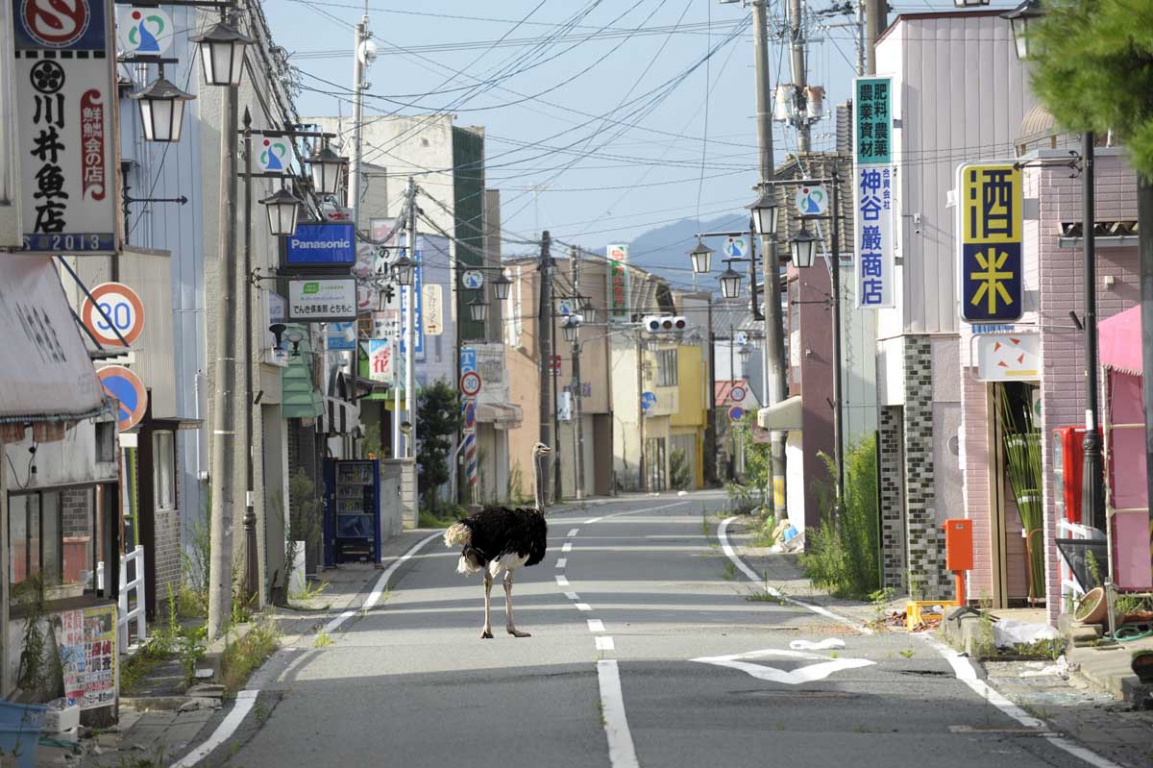There are basically two kinds of animals: the wild and the tame. Wild animals can flee when danger threatens, but this option is not usually open to tame ones. Pets are loyal to their surroundings, and farm animals depend heavily on human care. Animals are our ‘fellow travellers’, according to author and animal lover Rudy Kousbroek: ‘Man and animal are in the same boat and share the same fate’. These are the same people who swear that they would never leave their animals to their fate.
A day after a huge tsunami damaged a nuclear reactor at Fukushima in Japan on 11 March 2011, inhabitants living within 20km of the power plant were forcibly evacuated. Not only were they forbidden to take personal belongings; they also had to leave their household pets and farm animals behind. On 14 March, there was a hydrogen explosion at the power plant, so that it became uncertain when the evacuees could return home again.
The Japanese photographer and animal lover Yasusuke Ota (1958) was one of the volunteers who, at risk to his own life and carrying only animal feed and water, set out at the end of March 2011 to enter the ‘No go’ area that had been declared: everything within 20 kilometres of the Fukushima Daiichi Nuclear Power Plant. These volunteers had no clear idea what they would find, but they found themselves in a hell on earth: cows, on their knees and bellowing for lack of food and water, or released from their stalls but stuck fast in bogs and ditches, situations from which they could not possibly save themselves. They found emaciated horses and pigs in stalls alongside the corpses of their kind. Pets had died at their posts waiting for their owners to return, or had died of hunger because they were chained to their kennel or trapped indoors. Other animals had survived by eating whatever presented itself, and were still – 18 months later – patiently and innocently waiting for owners who will not be able to return.
Two books have since been published of the photographs Yasusuke Ota took in Fukushima between the end of March 2011 and March 2012. ‘This tragedy was for some reason not reported by the Japanese media at first, and the truth is that there has been no proper help given to these animals even after one and a half years. I felt I needed to inform the world and leave evidence of what really happened. So I started to take photos of this while going inside the zone on rescue,’ writes Ota. ‘Please don’t turn your eyes away from the reality.’
Ota made a heart-rending photographic document of the survivors and the fallen: a forgotten group of victims in the ruins of a landscape devastated first by a natural disaster and then by a man-made nuclear catastrophe. The photos raise the question of the nature of the invisible bonds linking people with animals. ‘On the basis of which psychological sense, which abstract image in the brain, do people feel called upon – not without danger to themselves – to save an animal that would otherwise undoubtedly be as good as dead?’ wrote Kousbroek. Yasusuke Ota’s own answer to this question is: ‘I can’t betray animals that don’t know how to doubt their owners, who wholeheartedly put their trust in them. With this in mind I documented these scenes from March 2011 to March 2012. This exhibition is to show that this tragedy was not caused by earthquake or tsunami. It’s the nuclear power plant.’
Many of Ota’s images are terrible: a mummified cat on the road; a dog’s lower jaw; a pigsty in the area right between the two nuclear reactors in Fukushima, with dozens of dead pigs. Other scenes are unintentionally comic, such as that of pigs trying to cool off in a shallow puddle of water in a street on a hot day, or that of the two escaped ostriches, omnivores, looking at each other after eating the cat food brought to them by a volunteer. A wry detail: ostriches were introduced to the region as mascots for the very Fukushima Daiichi Nuclear Power Plants. Ostriches grow on a small amounts of food; nuclear power is generated on a small amount of uranium.
Yasusuke Ota (1958) was born in Shiga Prefecture. He worked as a photographic assistant before becoming a cameraman for a production company. In 1991 he became a freelancer and joined The Photographic Society of Japan. In the late 1980s and early 1990s Yasusuke Ota worked in war zones in Afghanistan, Cambodia and the former Yugoslavia. He and his camera also infiltrated the nuclear power plant area in Taiwan.
Yasusuke Ota’s photos were brought to the attention of Huis Marseille by Dujat(the Dutch Japanese Trade Foundation) and the Nederland helpt Japan foundation. They will be exhibited for ten days, from 4 to 14 October, in Atelier 408 at Herengracht 408, a gallery belonging to Mrs. G. van Stigt-Amesz, five minutes’ walk from Huis Marseille. The exhibition will be opened on 3 October.
